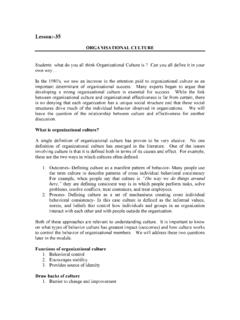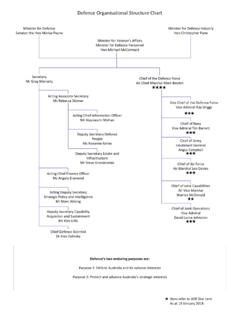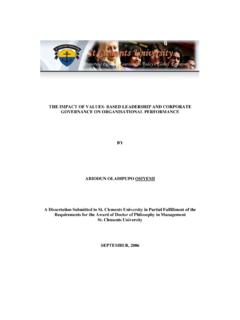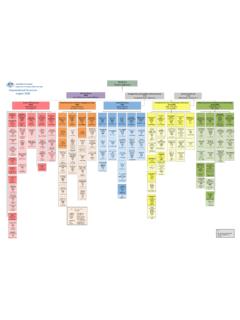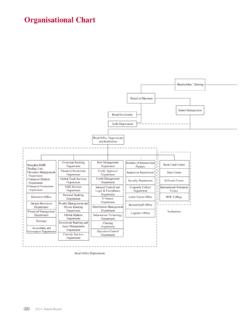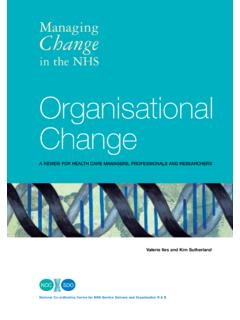Transcription of HSE Human Factors Briefing Note No 11 - …
1 -1- HSE Human Factors Briefing Note No. 11 organisational change Briefing Note 1 Introducing Human Factors explains the background to these Briefing notes . Organisations usually change for financial rather than safety reasons. Typical changes are: reducing the number of staff, reorganising departments and teams or adopting flexible working ( sharing maintenance and operations tasks). Organisations in the process of change need to manage their risks. Case studies A petroleum fire at a US refinery in February 1999 killed four workers and injured 46 others. It was caused by poor maintenance practices at the plant when working on a pipe containing naphtha, without proper isolation.
2 One of the findings of the investigation into the incident was that: Organizational changes were not reviewed by management to evaluate their potential impact on safety. We were told that following certain changes, organizational changes, employees were asked to take on new safety responsibilities with only limited training. Many employees perceived that organizational changes had a detrimental effect on morale and safety performance . Source: From a series of audits across a range of industries, it was found that many organisations have embarked on a process of significant change ; changing their structure, staffing levels, methods of operation, maintenance practices, and so on, without carefully considering the implications for risk to their operation, even though the organisations appear fully aware of safety management issues.
3 The commonest change is to reduce the workforce numbers and this has led, among other things to: Loss of skills and knowledge from the organisation Overloading remaining personnel Removing of hazard barriers Increased use of temporary contractors Formal systems in use that do not meet changed requirements breakdown of morale and culture. All of which can increase the organisations' safety, environmental and, ultimately, business risk. Source: Ref. 1 -2- HSE Concerns organisational changes are usually not analysed and controlled as thoroughly as plant or process changes. The key issue is that the direct and indirect effects of a proposed change on the control of major accident hazards should be identified and assessed.
4 Due to the greater potential consequences of an accident, major accident hazard sites should aim for higher reliability in their decision making. Our company manages change well because management: .. Tell the workforce when changes are likely to be made to the organisation .. Explain why these changes are necessary .. Consult with staff and involve them in planning changes .. Listen to workforce ideas and concerns .. Communicate throughout the change process .. Clearly understand the risks involved in the change .. Do all they can to reduce the risk .. Consider the potential for work overload in the new organisation .. Consider possible losses of skills and experience from the organisation.
5 Have sound procedures to manage the transition .. Arrange the training needed for anyone moving to a new role .. Continually check to see if the changes have been successful .. Make contingency plans if the change has not been successful .. Can cope with sudden unexpected change the sudden loss of key staff .. Learn from each change programme so that the next change will be trouble-free -3- Learning more about organisational change Why organisations change what can happen when they do A typical reason why an organisation may wish to change the way it is manned is to reduce costs. One way of doing this is to reduce the number of staff they employ. This means reorganising the departments/teams and plans may include introducing more automation or making more use of contract staff.
6 The danger is that the new organisation will not be as safe as the old organisation because it doesn t have enough people with the right skills and experience or knowledge to carry out the work safely. Possible Results of organisational change Potential Problems Suggested Solutions In general, the problems likely to arise are increased risk because the new organisation has: ..A smaller overall workforce: smaller teams doing the same work ..Fewer layers of supervision and management ..More automated plant ..Increased its reliance on contractors Overload personnel are given more or different types of tasks. They may need to be multi-skilled or more flexible in the work they can do - this will require additional training Teams may need to be self-managed they will need new skills and self discipline Reporting lines are unclear.
7 An individual or team might receive instructions from several managers New teams will need to learn new skills in using any automated plant and to learn new procedures Systems that worked well with a large workforce may not be suitable for a smaller workforce a simpler permit system may be preferred now Contractors may lack the skills and experience of full time employees; employees may need to develop skills in supervising contractors and this may add to their workload Consult with the workforce and develop ideas jointly with those subject to the changes proposed. Plan the change by mapping existing tasks onto the new organisation. Old tasks may either: i) disappear (because no longer needed) ii) be automated or iii) be done by contractors.
8 Make it clear who works for whom even if this changes between or even during shifts. Empower individuals to question conflicting instructions or unreasonable demands Make sure all tasks are accounted for, especially safety-related tasks. Consider: infrequent tasks ( start up and shutdown) and emergencies staff numbers needed to cover for sickness and holiday absences new skills that individuals will need Arrange training and other ways of gaining the competence needed including: management and supervisory skills, technical skills and knowledge. More trainers may be needed and allow time for learning. Plan contractor time on plant to make sure they maintain current knowledge and skills Assess the changes Monitor the effects of the change : find out people s opinions (what do they think about the change ?)
9 Beware of initial low morale people can be negative about change even though the new system is better). Collect data - for example, on near misses that have resulted from the change , delays or backlogs, excess working hours that may indicate overload. Have a fallback plan if the changes do show signs of increasing risks. Audit/continually improve Keep records of what worked well and what failed for future reference and to help with inevitable future changes. References 1. Gall, W (1996). The Management of change : General Findings. Presented at the Safety and Reliability Society Annual Conference, October 1996 2. HSE (2003) Information Sheet No CHIS7.
10 Available from: 3. HSE (1996) Business Re-Engineering and Health and Safety Management: Best Practices Model. CRR 123/1996 ISBN 0 7176 13 -4.










